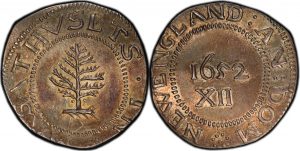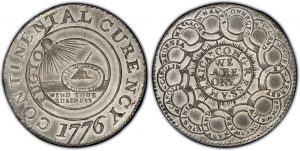In my continuing efforts to share my odd view of American history through the medium of our money, it’s time to talk colonies and gold. Since the Lydians first introduced the concept of coinage to the world ~3000 years ago and the first larger nation-states organized, there has been bickering about who is allowed to have which coins and made of what.
Until quite recently, the logistical systems to keep money well distributed throughout a realm were difficult and this regularly lead to money shortages, particularly at the periphery. This is extra bad for the periphery because you have troops there defending the frontier and, if you don’t pay them, pretty soon your frontier isn’t where you left it. When you add long overland or ocean journeys to these frontier locations it gets even worse and you start to wonder how it was, exactly, that any imperial/colonial power ever actually functioned.
The solution was to create local mints that could strike coins to pay the local troops and, more importantly, transform filthy foreign currency and freshly mined bullion to good, wholesome “real” currency with the correct ruler’s head on it. This was a calculated risk. Sending bullion out to local officials and giving them the power to mint coinage more or less invited secession and civil war (all you have to do is change the dies and now it’s your face on the coins and BAM! Instant Legitimacy). If you now have you own treasury, what makes you financially beholden to the Crown? The answer is simple: the Crown has waaaaaay more money than you and can buy your rebellion out several times over. Why does the crown have so much more you ask? The answer to that is also is relatively simple: you were only given brass & copper to work with for your coinage, maybe silver if you were important. The Crown’s treasury and mint was the only one that got to strike gold.
As you move forward through time, the perennial complaint from the colonies is that they send their gold to the capitol but only silver comes back. Then the next complaint is that what silver they get vanishes quickly into other people’s hands. The colony is underpaid for the raw materials being extracted and finished goods from the home country are overpriced. The solution is to make your own finished goods right? AHAHAHAHAHAH, that’s illegal, you colonial scum. The point of a colony is to enrich the the charter owners back home, not the colonists. Jeez. C’mon. Get with the program.
I want to focus this primarily to Britain’s colonial children, particularly America, but thematically the behavior of other colonial/imperial powers regarding their subordinate regions has been quite similar over the millennia. In the British context, the thing that dictated what colonies could and could not do was called the Royal Prerogative. In an abbreviated and not terribly legalistic sense, the Royal Prerogative was the collection of powers directly vested in the monarch, not in Parliament, and certainly not any of the local colonial assemblies. To this day, if you have QE2’s face on your coins, you are still subject to some residual bits of the Royal Prerogative, as exercised by the Governor-General with the tacit approval of HM Gov’t. And as coins are why I am writing, here’s the topics where the Royal Prerogative held longest and/or still hold:
- Monopoly on Force & Diplomacy – you don’t get to independently declare war & peace and you don’t get to organize armed forces without the Crown’s say so. If you have more than one army without a single, unitary command, you very soon have a civil war between rival generals. SEE ALSO: most all of history, particularly Rome, Persia, and China.
- Citizenship/Immigration – only the Crown gets to say who is a subject of the Crown. NOTE: this can get ugly and racist very fast.
- Currency – The only money that counts is what has been issued by the Crown. We’ll let you know if we feel like setting up a local Royal Mint in your colony, but that’s for our convenience, not yours.
What you get to mint and where it’s minted is where the story gets fun and starts running face first into the comedy of errors we like to call History. If you don’t already have some familiarity with the predecimalization system of British coinage, here is a handy reference guide. But I’ll warn you, that’s only a starting point for the headscratching multitude of money choices that Britain made for her many colonies.
Britain’s Largest Failed Colony: America
Well, that’s a bit wrong, it wasn’t just one colony and there were more than thirteen. Colonial “America” is better regarded as a collection of failed commercial enterprises that the Crown took over directly, the descendants of some religious nutbars & emigres from the English Civil War who had a relationship with the Crown best described as “tense and complicated”, and Stuff Stolen From The French/Dutch. In the early days of the British colonization of America, only Virginia was a Crown Colony directly ruled by the king, hence its nickname “Old Dominion”. New England was made up of royal charter colonies where a contract had been written up with the Crown to dictate how the place would be ruled somewhat autonomously in the Crown’s name (no one loves arguing a good charter/contract law more than a Puritan). Then there were the proprietary colonies (Pennsylvania, Maryland, New York) which had been granted to loyal courtiers as fiefs to develop as they pleased with absolute power over them. Lastly, were the colonies that were corporate concerns (Georgia and the Carolinas) which were established by companies paying a royalty to the Crown for the pleasure of extracting whatever they could. NOTE: at this point in history, what we now consider Canada was also “America”. Early British Canadian colonial history and organization ran similarly to Virginia’s as Crown Colonies, but with a whole lot more fighting with the French. I’ll get back to The Canadas in the next post.

Prior to the revolution, America functioned on an incredibly limited amount of coinage provided from the home country and on rare occasions they were allowed to mint their own coins locally like the Pine Tree Coin. Instead they had paper Colonial Currencies that were despised as being not quite worth the paper they were printed on and, doubly annoying, not easily transferable between colonies. This is one reason why the Interstate Commerce Clause is in the US Constitution: to make sure silly tariffs and trade barriers, much less independent currencies, didn’t pop up between states. For coinage, most all of it was copper in the farthing to penny range with the occasional silver threepence, sixpence, or LIVING LARGE big shilling-style. They were also explicitly forbidden to mint gold, which was an easy enough order to follow because there hadn’t been a gold strike in the colonies yet (America’s first gold rush in the Carolinas wouldn’t happen until after independence). English merchants weren’t even supposed to even bring gold coins to America.
The good news for the colonies is they didn’t particularly need to mint higher denomination silver because their world had been awash with very pure silver coins for almost 200 years at this point in the form of the Spanish 8 reales, AKA thalers. It was, unfortunately, very Spanish and the British hated that, considering trade from the colonies was supposed to be exclusively with British merchants. Technically, you weren’t supposed to use them. If you ever wondered why America and Canada have dollars rather than pounds, it’s because they were so used to the term: dollar is an English corruption of the German word thaler. But the importance of the 8 reales coin to American and world history is a topic for another time.
With no one in the colonies allowed to mint anything of higher denomination than a shilling, it is damn hard to run an internal economy. Consider trying to go buy a new car with small change; this is about the same problem of trying to commission a vessel to then ship anything within the colonies. For the most part, all the colonies worked on local credit systems and borrowed the term “wampum” from the New England tribes to describe debt-signifying goods and notes, which suffered bad inflationary problems and frequent devaluation. I highly recommend reading Graeber’s “DEBT: the First 5000 Years” to explain how debt exchange systems are the basis of economies and currency, not barter. Barter is what the Britain wanted the colonies to function on, with the mother country as the only acceptable trading partner for finished goods.

So, before 1775, the coins in America may be described as old, badly worn, low denomination, often foreign and, largely, counterfeit. Counterfeiting is a problem but, well, when you’re short of coins in the first place, you work with what you’ve got. When your colonial masters are squeezing you for more taxes (because war with the French is expensive even when you keep winning), but you don’t have any legitimate money to pay it, they flatly refuse to let you mint more locally, you have no representation in the Parliament to try to change their mind, and then Parliament decides colonial tea merchants still need to pay import duties but the East India Company awash in gold does not, what do think happens? This would also be why more or less the first order of business for the Continental Congress, right after slapping together the Continental Army (violating Royal Prerogative 1), was to work on making a Continental Currency (violating Royal Prerogative 3). One of the other things that Paul Revere did, as a silversmith, was volunteer bullion and his skills as an engraver to the Continental Congress to start minting coinage.
Please note that the Continental Currency didn’t actually have a denomination, it was just called The Continental. There weren’t many of the coin versions made because Congress was perennially short of bullion, so they printed paper Continentals to pay for the army. The only thing backing the paper Continental was the good faith and promises to freely exchange them for coins, as soon as we had some, which meant the value of the Continental was very much tied to the success of armies in the field and that was pretty poor for most of the Revolutionary War. Accordingly, the term “as worthless as a Continental” was thrown around, but for entirely different reasons, by both Tories and Patriots. Also, because I’ve gone nearly 2000 words without a poop joke, Continental was also slang for toilet paper. The American grumble* about fiat currency vs. bullion based is older than the country itself.
But what about the other British colonies? Did they get screwed with as badly as the backwater of America? What did America do when it had colonies of its own? FIND OUT NEXT TIME ON PHIL’S MONEY RANTS!
* there is no internet helldive deeper into the truly disgusting depths of the American psyche than Precious Metals social media and forums. There isn’t enough whiskey in the world for me to take the Journey to the Goldbug’s Lair again and it has some worrying overlaps with the cryptocurrency communities. When you see XAU to BTC price quotes at the top of a website, run. Don’t look back. Never look back. Just run.